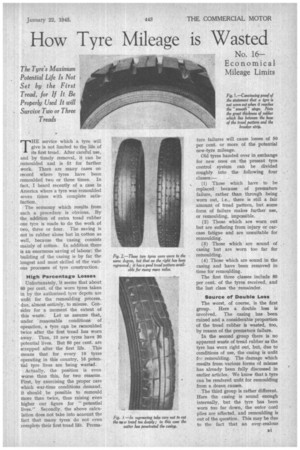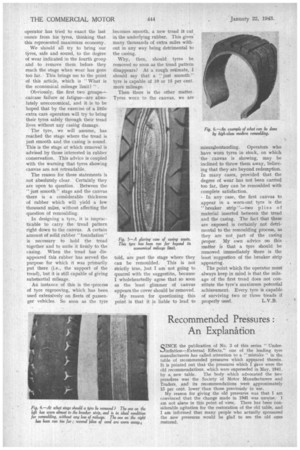How Tyre Mileage is Wasted
Page 27

Page 28

If you've noticed an error in this article please click here to report it so we can fix it.
The Tyre's Maximum Potential Life Is Not Set by the First Tread, for If It Be Properly Used It will Survive Two or Three Treads
THE service which a tyre will give is not limited to the life of its first tread. After careful use, and by timely removal, it can be .remoulded and is fit for further work. There are many cases on record where tyres have been remoulded two or three times. In fact, I heard recently of a case in America where a tyre was remoulded seven times with complete satisfaction.
The economy which results from such a procedure is obvious. By the addition of extra tread rubber one tyre is made to do the work of two, three or four. The saving is not in rubber alone but in cotton as well, because the casing consists mainly of cotton. In addition there is an enormous saving of labour; the budding of the casing is by far the longest and most skilled of the various processes of tyre construction.
High Percentage Losses
Unfortunately, it seems that about 80 per cent, of the worn tyres taken in by the authorized tyre depots are unfit for the remoulding process, due, almost entirely, to misuse. Consider for a moment the extent of this waste. Let us assume that, under reasonable conditions of operation, a tyre can be remoulded twice after the first tread has worn away. Thus, 10 new tyres have 30 potential lives. But 80 per cent, are scrapped after the first life. This means that for every 10 tyres operating in this country, 16 potential tyre lives are being wasted.
Actually, the position is even worse than this, for two reasons. First, by exercising the proper care which war-time conditions demand, it should , be possible to remould more than twice, thus raising even higher our figure for "potential lives." Secondly, the above calculation does not take into account the fact that many tyres do not even complete their first tread life. Prema ture failures will cause losses of 50 per cent. or more of the potential new-tyre mileage.
Old tyres handed over in exchange for new ones on the present tyre control system can be divided roughly into the following four classes:— . (I) Those which have to be replaced because of premature failure, rather than through being worn out, i.e., there is still a fair amount of tread pattern, but some form of failure makes further use, or remoulding, impossible.
(2) Those which are worn out but are suffering from injury or carcase fatigue and are unsuitable for remoulding.
(3) Those which are sound of casing but are worn too far for remoulding.
(4) Those which are sound in the casing and have been removed intime for remoulding.
The first three classes include 80 per cent. of the tyres received, and the last class the 'remainder.
Source of Double Loss The worst, of course, is the first group. Here a double loss is involved. The casing has been ruined and a considerable proportion of the tread rubber is wasted, too, by reason of the premature failure. In the second group there is no apparent waste of tread rubber as the tyre has worn right out, but, due to conditions of use, the casing is unfit fe: remoulding. The damage which results from various forms of misuse has already been fully discussed in earlier articles. We know that a tyre can be rendered unfit for remoulding from a dozen causes.
The third group is rather different. Here the casing is sound enough internally, but the tyre has been worn too far down, the outer cord plies are affected, and remoulding is out of the question. This may be due to the fact that an over-zealous operator has tried to exact the last ounce from his tyres, thinking that this represented maximum economy.
We should all try to bring our tyres, safe and sound, to the degree of wear indicated in the fourth group and to remove them before they reach the stage when wear has gone too far. This brings me to the point of this .article, which is " What is the economical mileage limit? .
Obviously, the first two groups—'carcase failure or fatigue—are absolutely uneconomical, and it is to be hoped that by the exercise of a little extra care operators will try to bring their tyres safely through their tread lives without any casing damage_ The tyre, we will assume, has reached the stage where the tread is just smooth and the casing is sound. This is the stage at which removal is advised by those interested in rubber conservation. This advice is coupled with the warning that tyres showing canvas are, not retreadable.
The reason for these statements is not absolutely dear. Certainly they are open to question. Between the "just smooth" stage and the canvas there is a considerable thickness of rubber which will yield a few thousand miles, without affecting the question of remoulding.
In designing a tyre, it is impracticable to carry the tread pattern right down to the canvas. A certain amount of solid rubber "foundation" is necessary to hold the tread together and to unite it firmly to the casing. When the tread has disappeared this rubber has served the purpose for which it was primarily put there (i.e., the support of the tread), but it is still capable of giving substantial mileage.
An instance of this is the 'process of tyre regrooving, which has been used extensively on fleets of passenger vehicles. So soon as the tyre
becomes smooth, a new tread iS cut in the underlying rubber. This gives . many thousands of extra miles without in any way being detrimental to the casing.
Why, then, should tyres be removed so soon as the tread pattern disappears? At a rough estimate, I should say that a ',' just smooth" tyre is capable of 10 or 15 per cent. more mileage.
Then there is the other matter. Tyres worn to the canvas, we are told, are past the stage where they can be remoulded. This is not strictly true, but I am not going to quarrel with the suggestiOn, because I wholeheartedly agree that so soon as the least glimmer of canvas appears the cover should be removed.
My reason for questioning this point is that it is liable to lead to
misunaerstanding. Operators who have worn tyres in stock,. on which the canvas is showing, may be inclined to throw them away, believing that they are beyond redemption. In many cases, provided that the degree of wear has not been carried too far, they can be remoulded with complete satisfaction.
• In any case, the first canvas to appear in a worn-out tyre is the "breaker strip "—two plie s of material inserted between the tread and the casing. The fact that these are exposed is certainly not detrimental to the rerriOuIding process, as they are not part of the casing proper. My own advice on this matter Ls that a tyre should be removed immediately there is the least 'suggestion of the breaker strip appearing.
The point which the operator must always keep in mind is that the mileage of the first tread does not constitute the tyre's maximum potential achievement. Every tyre is capable of surviving two or three treads if
properly used. L.V.B.




























































